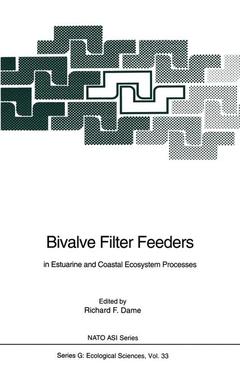Bivalve Filter Feeders, Softcover reprint of the original 1st ed. 1993 in Estuarine and Coastal Ecosystem Processes Coll. Nato ASI Subseries G:, Vol. 33
Langue : Français
Coordonnateur : Dame Richard F.

Bivalve filter-feeding mollusks are important components of coastal ecosystems because they remove large quantities of suspended material from the water and excrete abundant amounts of reactive nutrients. These animals are also major prey for numerous predators including birds, fish, mammals, and invertebrates; furthermore, they are significant food resources for humans. While studies on the organismic and population level have dominated bivalve ecology, the recent focus on the ecosystem roles of filter feeding systems has led to larger-scale investigations. With this approach the specific topics of physiology, grazing, predation, nutrient cycling, physical environment, computer simulation modeling, and environmental management are combined into a meaningful whole.
Feeding Physiology of Bivalves: Time Dependence and Compensation for Changes in Food Availability.- Infaunal Filter-Feeding Bivalves and the Physiological Response to Short-Term Fluctuations in Food Availability and Composition.- Phytoplankton-Mussel Bed Interactions in Intertidal Ecosystems.- Grazing of Natural Particulates by Bivalve Molluscs: A Spatial and Temporal Perspective.- Invertebrate Predators and their Role in Structuring Coastal and Estuarine Populations of Filter Feeding Bivalves.- The Impact of Bird Predation on Marine and Estuarine Bivalve Populations: A Selective Review of Patterns and Underlying Causes.- The Role of Bivalve Filter Feeder Material Fluxes in Estuarine Ecosystems.- The Uptake of Organic Matter and the Release of Inorganic Nutrients by Bivalve Suspension Feeder Beds.- Hydrodynamic Control of Bivalve Filter Feeders: A Conceptual View.- Bivalve Feeding and the Benthic Boundary Layer.- Perspectives on Field Studies and Related Biological Models of Bivalve Growth and Carrying Capacity.- A Set of Models to Investigate the Role of Benthic Suspension Feeders in Estuarine Ecosystems.- Why Carrying Capacity Models are Useful Tools for Management of Bivalve Molluscs Culture.- Integrated Estuarine Management — Obtaining a Sustainable Yield of Bivalve Resources While Maintaining Environmental Quality.- Poster Abstracts.- Working Group Reports: Physiology and Grazing.- Predation and Population Dynamics.- Material Processing.- Modelling.- Physical Factors.- The Role of Scientists in the Management of Coastal Ecosystems.- Bivalve Filter Feeders and Estuarine and Coastal Ecosystem Processes: Conclusions.
Date de parution : 01-2012
Ouvrage de 579 p.
15.5x23.5 cm
Disponible chez l'éditeur (délai d'approvisionnement : 15 jours).
Prix indicatif 158,24 €
Ajouter au panierThèmes de Bivalve Filter Feeders :
© 2024 LAVOISIER S.A.S.



